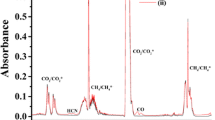Abstract
Conversion of the gaseous mixture CO2(g)+N2(g)+H2O(g) to a solid amino acid condensate in an electric discharge plasma has high efficiency of the energy transfer from the different plasma components into chemical processes. The basic activation process is activation of the N2 metastable electronic state, followed by formation of NCO* and ON-NCO free-radicals and generation of many reactive radicals. These radicals help to overcome the high activation energy of thermal dissociation of N2 to N (950 kJ=9.846 eV).
The major product is a statistical polycondensate containing the amino acids: arginine, lysine, histidine, methionine, glycine, alanine, serine and aspartic acid. This information was obtained by comparing the IR spectra of the products with reference IR absorption spectra of pure components. Identification of the individual amino acids in the solid product was performed by HPLC, when samples were dissolved using 6 M HCl applied at 100°C for 24 h. Properties of the condensate were estimated using thermogravimetric analysis. Small amounts of oxamidato complexes and oligo pyrrole structures are formed on the electrode surface giving the surface catalytic properties. The gas cleaning process has practical applicability (production of useful fertilizers, reduction of the CO2 concentration in the atmosphere) and may also contribute to explanation of the origin of life on Earth.
Similar content being viewed by others
References
United Nations Framework Convention On Climate Change, Kyoto, Dec. 1.10. 1997.
IPCC Climate change 1995 - the science of climate change, summary for policymakers and technical summary of the working group I report, Cambridge University Press, Cambridge, UK 1996.
A., Dictionary of Environmental Science and Technology, Wiley, Chichester, UK 1996.
D. J. Wuebbles, in Global Atmospheric Chemical Change, (Eds C. N. Hewitt and W. T. Sturges), Elsevier, 1993.
J. Houghton, Global Warming, The Complete Briefing, Lion Publishing, Oxford, UK 1994.
M. Kurdel and M. Morvová, Czech. J. Phys., 47 (1997) 205.
K. Hensel and M. Morvová, Contribution to Plasma Physics, 36 (1996) 51.
M. Morvová, I. Morva, Z. Machala and M. Janda, Proceedings of 14th ISPC, Volume V, (Ed. M. Hrabovský, M. Konrád and V. Kopecký), Praha, August 2.6, 1999, p. 2533.
M. Morvová, J. Phys. D: Appl. Phys., 31 (1998) 1865.
M. Morvová, I. Morva and F. Hanic, Proc. of the 4th International Conference on Greenhouse Gas Control Technologies, 30 August.2 September 1998, Interlaken, Switzerland, (Ed. B. Elliasson, P. Riemer, A. Wokaun), Elsevier Science, Oxford, UK 1999, p. 137.
M. Morvová, F. Hanic and I. Morva, J. Therm. Anal. Cal., in press.
I. L. Karle, in The Peptides, (Ed. E. Gross and J. Meienhofer), Vol. 4, Academic Press, New York 1981, p. 1.
I. L. Karle, in Molecular Structure and Biological Activity, (Eds J. F. Griffin and W. L. Duax), Elsevier, Amsterdam 1982, p. 215.
A. I. Oparin, The Origin of Life, Macmillan Publishing, New York 1938.
J. F. Fawcett, N. Camerman and A. Camerman, Acta Crystallogr. B, 21 (1975) 658.
A. Lofthus and P. H. Krupenie, J. Phys. Chem. Ref. Data, 6 (1977) 113.
W. F. Cooper and J. F. Hershberger, J. Phys. Chem., 96 (1992) 771.
B. A. Žubanov, O. V. Agaškin and L. B. Ruchina, Atlas of IR Spectra Of Heterocyclic Monomers And Polymers, Nauka, Alma Ata 1984.
S. L. Miller, in Major Events in the History of Life, (Ed. J. W. Schopf) Jones & Bartlett, Boston, Mass. 1992, Chap. 1, p. 1.
Author information
Authors and Affiliations
Rights and permissions
About this article
Cite this article
Hanic, F., Morvová, M. & Morva, I. Thermochemical Aspects of the Conversion of the Gaseous System CO2-N2-H2O into a Solid Mixture of Amino Acids. Journal of Thermal Analysis and Calorimetry 60, 1111–1121 (2000). https://doi.org/10.1023/A:1010152901749
Issue Date:
DOI: https://doi.org/10.1023/A:1010152901749




